Camels of the Australian Outback
Camels of the Australian Outback Here’s a trivia question : where are the world’s only wild single-hump (dromedary camel) camels found? If you guessed Arabia or the Sahara, you’d be wrong. In fact, the answer…
16 Jul 20 · 6 mins read

Camels of the Australian Outback
Here’s a trivia question : where are the world’s only wild single-hump (dromedary camel) camels found? If you guessed Arabia or the Sahara, you’d be wrong. In fact, the answer is the deserts of central Australia, where their imported ancestors (camelus dromedarius) were freed after playing a key role in the settlement of the Australian outback .Today, no-one is sure how many camels in Australia roam central Australia and beyond. They are a feral camel with more than 100,000 out in the Australian desert surviving on native vegetation and roaming over Aboriginal land.
The use of the camel to tame the desert likely dates back over 4500 years, when the first camels were tamed on the Arabian Peninsula, before spreading across the Middle East and Asia over subsequent millennia.
For nomadic peoples of Middle Eastern and Asian deserts, camels are at the heart of life. Camel milk is a chief source of nutrition; camel hides make tents and leather goods; hair is woven into rugs and fine fabrics. Camel meat is commonly eaten at feasts and festivities.
Today, out of the world’s 13 million camels, only 600, 000 still live on the Arabian peninsula. Over 11 million live elsewhere in the Middle East and Africa, nearly half of these in Somalia and Sudan. There are estimated to be in Australia, a feral camel population of 100, 000 in outback Australia today, many of them are a feral animal, as the wild camel, an introduced species, are properly called.
Incredibly, the Eurasian population of camels is entirely in human hands, making it impossible to tell how camels lived prior to domestication. For the Conservation Commission of Australia‘s Northern Territory, the behaviour of Australia‘s feral camel is of major interest as a means to understand how camels behave in the wild, and to explore their impact on the surrounding environment.
The first camel to arrive in Australia reached Port Adelaide in 1840, the sole survivor of a group shipped from the Canary Islands, off north-west Africa. Inspired by their use in the Middle East and North Africa, the camel seemed the ideal for opening up huge swathes of arid Australian desert land.
At first, the camels received mixed reviews. Their first major test was the expedition of Burke and Wills, who brought 26 camels, 23 horses and six wagons of provisions on their lavishly funded quest to reach the north of Australia. Soon finding all the wagons and supplies to be a burden, Burke and Wills left the camels with their men, pressing ahead into the Australian outback – where they soon met with disaster.
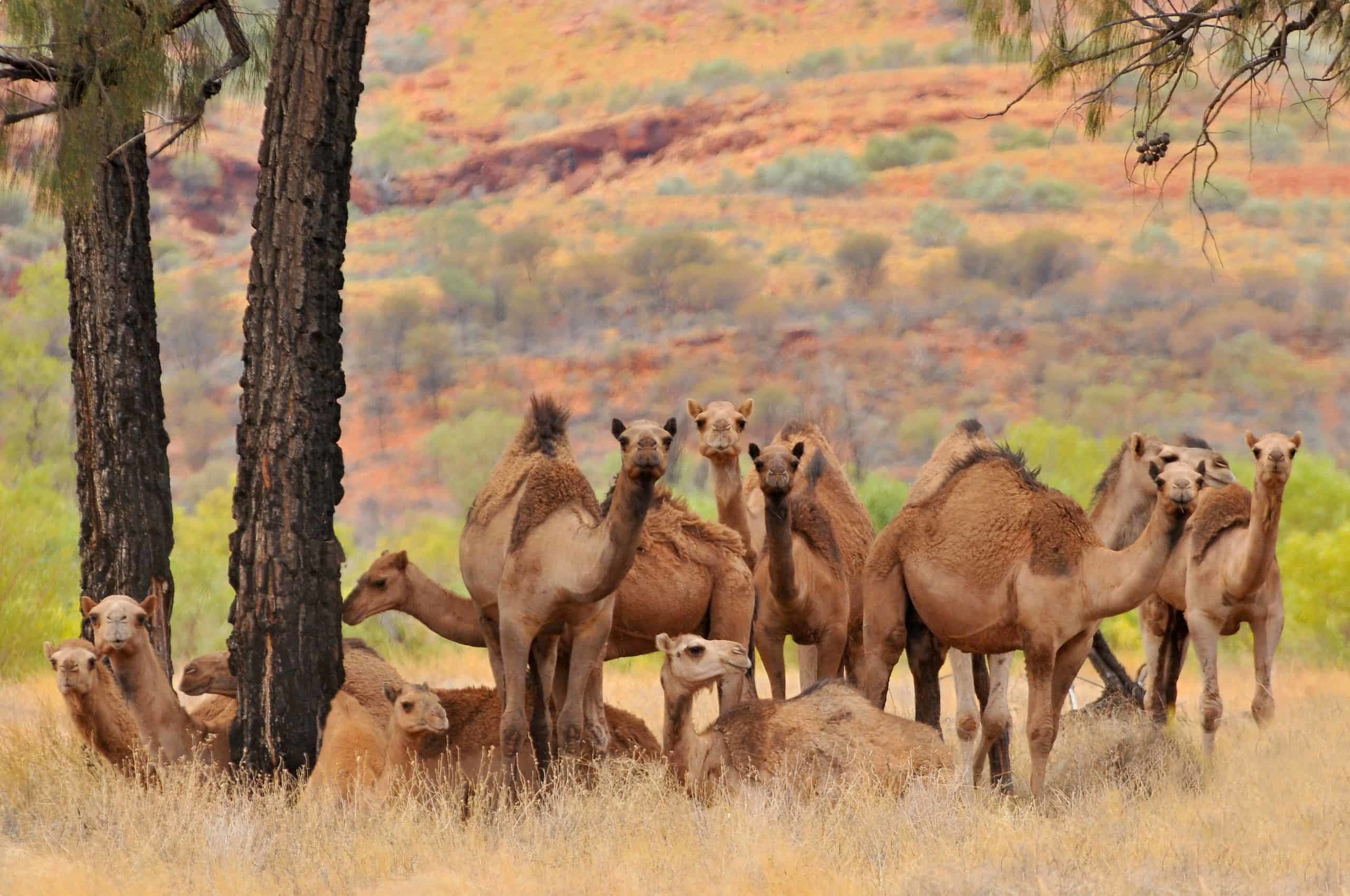
However, the emergence of Australian camels would prove more successful on subsequent exploration journeys that covered vast distances across central and Western Australia, including those journeys of Ernest Giles, Peter Warburton, William Gosse and Harold Lasseter.
Soon, Australia‘s camel became a familiar sight across outback Australia. In total, more than 10, 000 camels were imported to Australia in the late 19th century. Guided by cameleers from the Middle East and Asia, they brought goods from the cities to remote pastoral stations, helped build the Overland Telegraph Line along an ancient Aboriginal trading route , played a key role in creation of the Canning Stock Route, and in laying out the Trans-Australia and Central Australian railway lines.
The dromedary camel as a species is ideally adapted for desert survival. The hump, once thought to be a water store, is a well-placed fat reserve that allows the camel to regulate body temperature. Because fat is concentrated in one spot excess heat can be dissipated through a thin layer of skin elsewhere. The hump also shields the body from the impact of the sun.
Camels can deal with dehydration exceptionally well, losing up to 40% of their body weight without excessive thickening of the blood. In extreme conditions, they can survive 20 days without access to a water source.
Australia‘s camels were operated and trained by men from India, Iran, Turkey, the Middle East and North Africa, collectively known as ‘Afghans’ or the ‘Ghans’. From 1870 to 1900, it is estimated that over 2000 cameleers came to Australia. As historian Anna Kenny argues, the ‘Afghan’ cameleers played a vital role in constructing modern Australia:
“The cameleers opened lines of supply, transport and communication between isolated settlements, making the economic development of arid Australia possible. They also enriched the cultural landscape.”
Despite this, life in Australia was often hard and unwelcoming for the cameleers. Usually young or middle-aged men, many left wives and children behind on three-year contracts. They rarely found acceptance from Australia‘s settler communities. Many towns – such as Marree and Farina – were divided into segregated quarters for whites, Aboriginals, and ‘Afghans’. Camelmen often found more acceptance among Aboriginal communities, with some men marrying Aboriginal women and starting families.
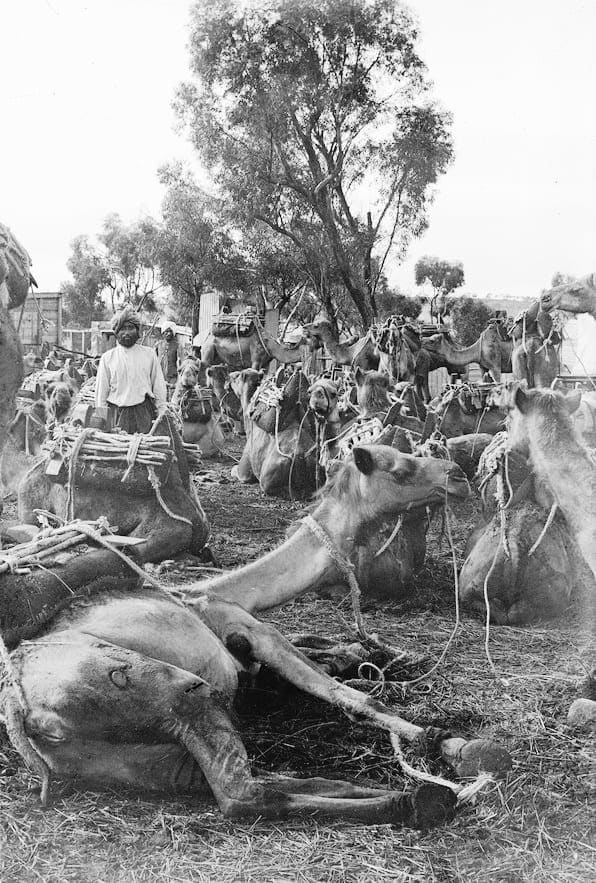
Though the ‘Afghans’ were from a variety of different countries and spoke an array of languages, they were generally united by their Muslim faith. Islam became a source of solace and a means of building community. Mosques dot the Australian interior, including Australia’s first mosque at Marree, built 1861, and the 1891 Broken Hill mosque.
However, the story of the camelmen should not only be understood as one of marginalisation. Camelmen lead one of Australia’s first successful strikes, on Beltana Station, South Australia, in 1870. By the end of the 19th century, Australia’s camel industry was controlled by the ‘Afghan’ cameleers, with business-owners such as Abdul Wade and Gunny Khan becoming wealthy as a result.
By the 1920s, the motorcar brought the heyday of the camel to an end. Animals that (in today’s terms) sold for thousands of dollars were now worthless. Unwanted, they were released into the Australian desert, where they became feral.
Today, many regard Australia‘s camel population as a feral animal, who break the pipes and fences of outbackcommunities, and strip away the native vegetation, and compete for the water source in the traditional feeding grounds of native animals. For others, the camels are once again a business opportunity. In 1994, camel tourism was an industry worth $2.5 million in the Northern Territory alone. Other camels are sold to the United States, for use in their deserts, while camel farms in Queensland produce dairy goods using camel milk, from feta cheese to salted-caramel gelato.
Whatever your perspective, Australia‘s camels are a palpable legacy of the fascinating and diverse histories of the ‘red centre’.
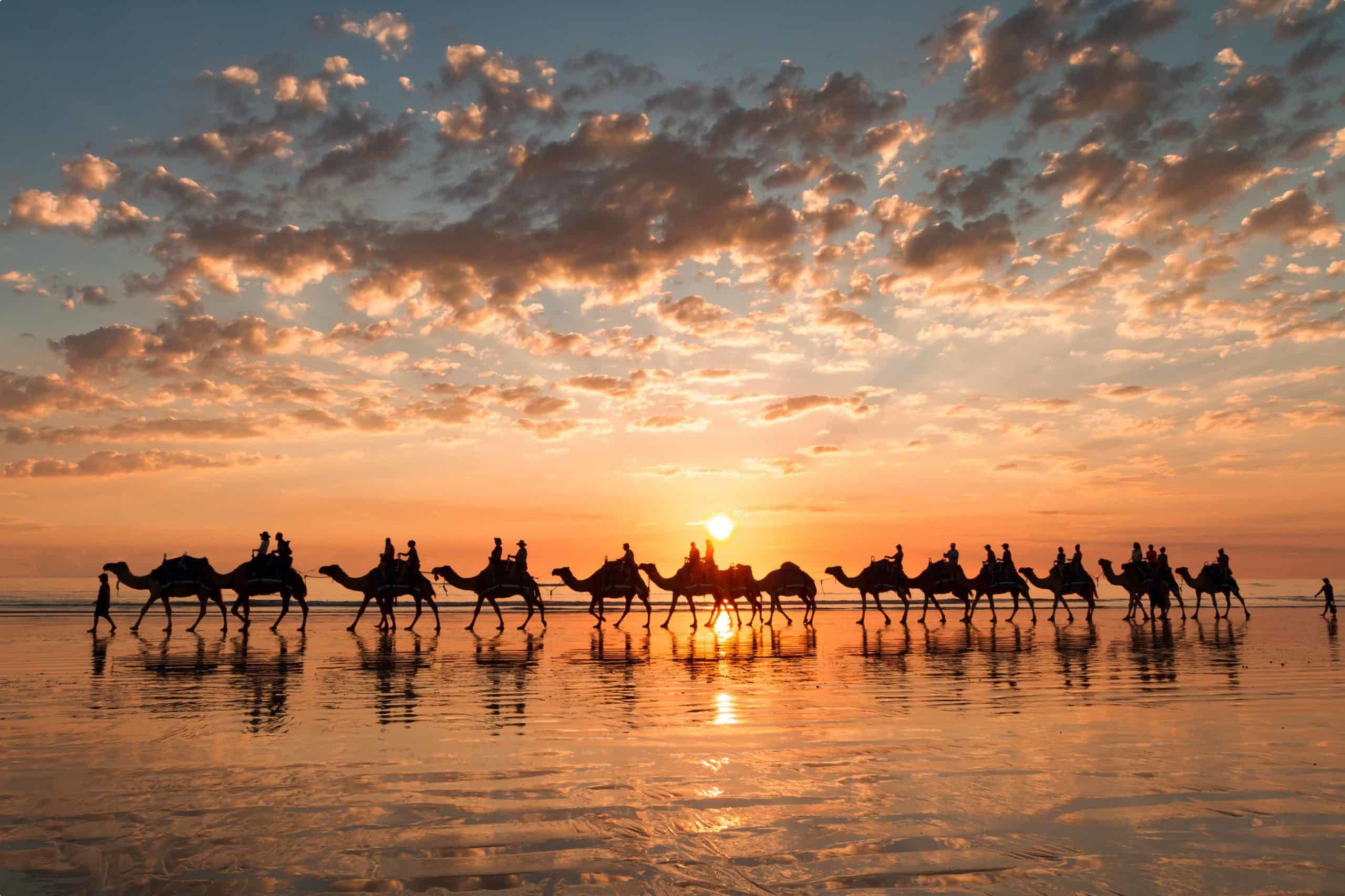
Odyssey Traveller is now offering a number of tours of the Outback. Designed for curious mature-aged and senior travellers, our tours go beyond the cliches, to tell the fascinating and multi-layered history of inland Australia.
Our tours include:
- Tour of Outback Queensland: This tour takes in the quintessential outback Australia – Longreach and the Stockman’s Hall of Fame, Winton and dinosaurs, and Barcaldine, home of the Australian Labor Party – on a journey through remote western Queensland.
- Outback Tour – Broken Hill and ‘Back: Beginning and ending in Broken Hill, New South Wales, this tour passes through some of the most remote areas of Australia‘s red dirt centre, taking on the Birdsville Track, regarded by many as Australia‘s ultimate outback adventure.
- Tour of the Flinders Range: This guided tour takes in the stunning landscapes of Wilpena Pound and the Flinders Ranges National Park, as well as the quintessential outback experience of Coober Pedy and the Oodnadatta Track.
- Tour of the Eyre Peninsula: The Eyre Peninsula is Australia‘s seafood frontier, where the Gawler Ranges (home to possibly Australia‘s most vivid night sky) and the arid mallee reach the crushing waves of the Southern Ocean.
- Tour of Kakadu and the ‘Top End’: Devoted to spectacular Kakadu National Park, our itinerary also experiences a vibrant Aboriginal culture in Arnhem Land and makes a day tour of Litchfield National Park.
- Tour of the Kimberley: Our trip through the Kimberley, Western Australia might be the ultimate Australian outback tour, offering the beautiful desert landscape of the Gibb River Road, ancient Aboriginal rock art, and gold rush history in one of Australia‘s most sparsely populated regions.
- Southern States of Australia – UNESCO World Heritage Sites and more: This tour uncovers the rich Aboriginal history of Australia, touring two important world heritage sites (the Budj Bim Cultural Landscape and the Willandra Lakes), along with Mildura, the outback town of Burra, and the ‘shipwreck coast’ of Port Fairy, Western Victoria.
Every Odyssey Tour is led by an experienced travel director; and is joined by a knowledgeable tour guide in most destinations. We move in small groups of around 6-12 travellers. The tour price includes transport in a comfortable vehicle suited for our terrain, accommodation, entrance fees for attractions, and several group dinners.

Articles about Australia published by Odyssey Traveller:
- The Kimberley: A Definitive Guide
- Uncovering the Ancient History of Aboriginal Australia
- Aboriginal Land Use in the Mallee
- Understanding Aboriginal Aquaculture
- Mallee and Mulga: Two Iconic and Typically Inland Australian Plant Communities (By Dr. Sandy Scott).
- The Australian Outback: A Definitive Guide
- The Eyre Peninsula: Australia’s Ocean Frontier
- Archaeological mysteries of Australia: How did a 12th century African coin reach Arnhem Land?
- Ancient Aboriginal trade routes of Australia
For all the articles Odyssey Traveller has published for mature aged and senior travellers, click through on this link.
External articles to assist you on your visit to Australia:
Related Tours
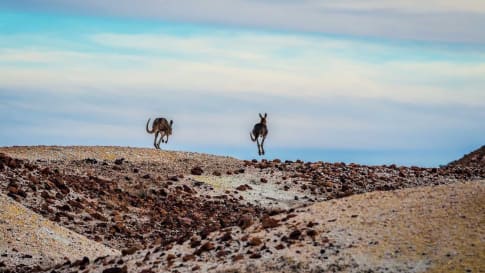
13 days
Mar, OctSmall group tour; Broken Hill and back
Visiting New South Wales, Queensland
Small group tour of New South Wales, Queensland & South Australia deserts, from Broken Hill. Learn about the history of the people who explored the deserts, from indigenous communities to Europeans, as well as Burke and Wills, visit White Cliffs, Birdsville, Maree.
From A$11,550 AUD
View Tour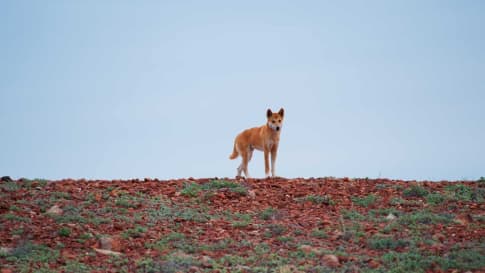
days
Apr, May, Jul, Aug, Oct +2Small group tour of Australia's Flinders ranges
Visiting South Australia
Escorted small group tour of the Flinders range in South Australia from Adelaide. Learn about Coober Pedy, Wilpena pound and water system of Lake Eyre as we explore and learn also about the history of the people who explored the Flinders.

days
Mar, May, Aug, Sep, Oct +2Small group tour of World Heritage sites and more in the Southern States of Australia
Visiting New South Wales, South Australia
Discover the World Heritage Sites of the southern states of Australia travelling in a small group tour. A journey of learning around the southern edges of the Murray Darling basin and up to the upper southern part of this complex river basin north of Mildura. We start and end in Adelaide, stopping in Broken Hill, Mungo National Park and other significant locations.




